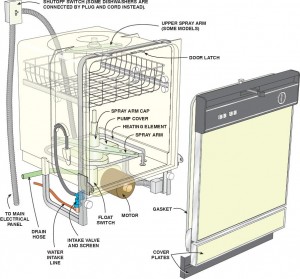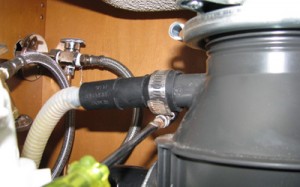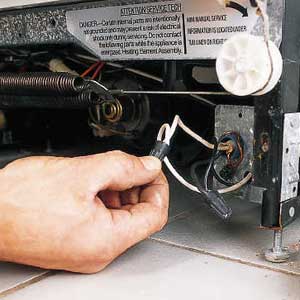How To Install A Dishwasher
Installing A Dishwasher


As with any home improvement project make sure you follow the manufacturers instructions carefully and obey all local laws involving plumbing and electrical codes. The first step should always be to shut off both the electrical power supply and water supply to the existing unit. The water supply shut off valve is typically located in the cabinets below your kitchen sink. The power supply should be hooked up to an independent breaker in your main service. After you shut off the electrical breaker make sure you test the power to verify that it’s shut off.


At this point you should be able to remove any screws holding the dishwasher in place. Typically the screws are either attached to the counter top or sides of the cabinets. Some dishwashers are now being screwed into the floor along the bottom steel runners (this is due to the popularity of granite counter tops that cannot be drilled into). Once you remove the screws you should be able to remove the old dishwasher from under the counter top.
To install the new dishwasher you’ll basically reverse the previous steps. Again remove the lower toe-kick cover plates so you can access the electrical junction box and the water supply line connection. As you slowly push the new dishwasher under the cabinet make sure you guide the drain line back through the cabinets into the sink base. Make sure you grab the electrical wires and water supply lines and pull them forward as you slide the washer back.


Products You Might Need to Buy:
As I said this is a fairly straight forward do-it-yourself project. Just make sure to take your time, shut off power and water and follow the manufacturers directions closely.
Recent Posts
Framing Stick Nailer vs Coil Nailer
Which is Better a Stick Nailer or Coil Nailer? Framers have many choices in nailers…
How Many Roofing Nails Per Square of Shingles
Estimating How Many Nails for a New Roof When it comes to estimating materials for…
Composite / PVC Decking – Layout Tips & Advice
Composite / PVC Decking Layout Tips and Advice Composite and PVC decking have really changed…
Benefits of an ERV System (Energy Recovery Ventilator)
Benefits of ERV Systems (Energy Recovery Ventilator) If you're building a new home or doing…
Vermiculite Attic Insulation Abatement
Vermiculite Attic Insulation If your home was built before 1990 there is a chance it…
Nuisance Tripping of AFCI (Arc Fault) Circuit Breakers
Arc Fault (AFCI) Circuit Breakers Tripping Often An arc-fault circuit interrupter (AFCI) or arc-fault detection…
View Comments
I like the new setup! It looks very professional.
Great post (and blog format)! I haven't had to work on my dish washer yet, but it may be the next major appliance we swap out.
Replacing a dishwasher sounds intimidating but actually it's a really straightforward project.
I have a question about the ground wire. I have a long, copper wire that comes out of the existing electrical line and the instructions tell me to put it behind the "green" screw in the electrical box. This I get, however, my wires are extremely long and part of the ground wire will probably touch other parts of the box. Is this a problem? I don't want to get shocked when trying to do a load of dishes.
@ Jarrod - Not sure if I completely understand your question. However, the ground wire is always "bare" inside of electrical boxes and almost ALWAYS touches the box. Not worries for that situation.
Hi- Thank you for your help...I have one question. I reused my old water line successfully (so far) BUT am wondering if it is a problem to have that copper line touching any other parts under the dishwasher? I am thinking that that line gets pretty hot and should not be near or touching the plastic/rubber parts of the hoses but I have read/watched many DIY instructions and no one had any warning or precaution against doing this. My copper water line IS touching/very near the hose and I am not sure if this is going to be a problem but after a couple attempts, I was unable to move it far enough away and still be able screw it into the dishwasher. Should I replace it with a flexible water line or does it not get hot enough to matter?
@ Jennifer - The water should not get hot enough to melt plastic or rubber hoses. As far as I'm concerned I would not move it. Best of luck!
i,m needs a schematic diagram and circuit diagrams of dishwasher. where can i get it.
i'm need it for my final year project. hope you will help me out. please email me at ak_bdkbaik@yahoo.com
I was wondering if you can use a standard electrical, heavy guage cord, so that you could plug into the outlet, instead of hard wiring with 12-2 romex. Thanks!
Larry - Many people do that. Just be sure the chord is rated for the amperage you're using.
I have one of this model , but i dont know what kind of detergent can i use for this model and i dont know ¿where can i put the detergent?
Hi Todd
Need a wiring diagram for dishwasher Defy DDW 143. Can U help?
Sorry I don't have that information.
Thank you so much! this is exactly what I am looking for. I appreciate all the details, they have helped so much.
Keep up the good work.